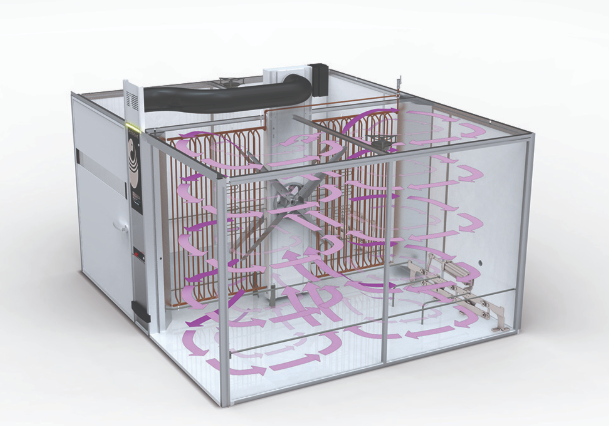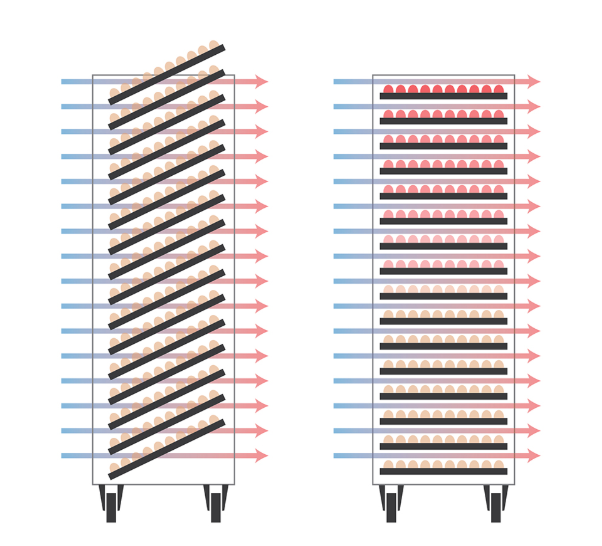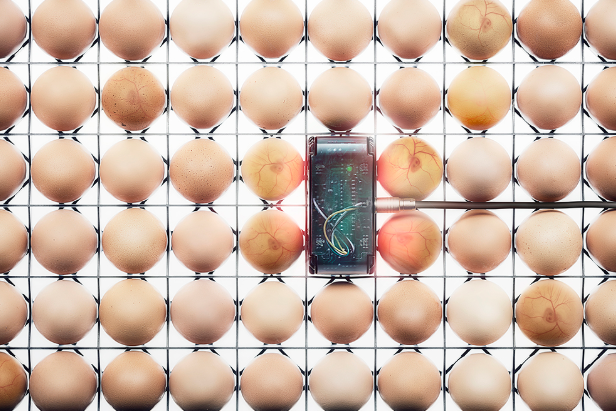



Loading egg incubators for optimal heat balance (Part 1)
It’s no secret that temperature differences in the incubator cause a wider hatch window and negatively affect chick uniformity.Although it’s not evident, we can use incubated eggs to make the incubator’s environment even more homogeneous. Or, as it happens in most cases, we create an even wider temperature range by setting a mix of eggs in wrong positions. Does this sound familiar? In this series of 3 articles, we will teach you the best possible ways to combine eggs from different flocks with the micro-environment in the incubator.
By Eduardo Romanini, Hatchery Development Specialist, Petersime
Part 1: Understanding heat exchange and embryo heat production
Basically, the range of temperature differences is not the same in all incubators. It depends a lot on the layout and design of single-stage incubators in association with heating/cooling patterns and airflow dynamics.
Keeping the difference between the highest and lowest temperatures inside the machines as small as possible will ultimately define the incubation results. It will certainly affect the rate of embryonic development and their hatching time.
For this reason, loading the machines with eggs from different flocks and positioning them correct becomes critical. Are you wondering how? Let’s start with some basic concepts.
Heat exchanges in incubated eggs
Incubated eggs are constantly exchanging heat with the surrounding micro-environment. The setters’ central mixing fan creates an airstream that passes through the eggs and absorbs the metabolic heat that is generated by the growing embryo.
This process is called ‘heat transfer by convection' and it proves that air speed can have a great impact on the eggshell temperature. Depending on the embryo developmental stage, higher air velocities can cause more heat transfer into or out of the egg.
For instance, eggs positioned near the central mixing fan will be subjected to a slightly more efficient convection. On the other hand, eggs in the central trolleys, will be subjected to slightly lower convection. This is caused by the spiral format of airflow and the barriers of eggs to the airstream on both sides.
Petersime incubator with spiral airflow distribution for optimal heat exchange
The laws of physics confirm this process: in any confined three-dimensional space like an incubator, a faster air speed will result in a higher convective heat exchange. In Petersime incubators, the advanced fan blade design creates a spiral airflow distribution in the machine. Depending on whether the heating or cooling elements next to the fan are activated, this spiral airflow reduces the increase or decrease in temperature to a minimum at different positions in the incubator.
But that’s not all, turning the eggs is also important for heat exchange. Next to its physiological importance (embryo positioning, bilateral vascularisation and yolk utilisation), it optimizes the airflow dynamics in the incubator in a symmetrical manner. By regularly alternating the trays’ rotation position into the "A" and "V" profiles, the airstream passage through the eggs is improved in comparison to levelling the eggs horizontally.

The airflow when turning the trays’ rotation into the "A"/"V" or horizontal profiles
At this point, it should be clear that heat exchange between an egg and the surrounding micro-environment is constantly changing during incubation. So far, the best practical way to follow the heat gain or losses from or to the incubator environment is by monitoring the eggshell temperature.
For this reason, Petersime incubators are equipped with OvoScan™ technology. This system automatically adjusts the temperature of the environment by measuring eggshell temperature.
OvoScan™: creating the optimum environment for any batch of eggs, whatever the size, age or genetic content of the hatching eggs
Heat production in mixed eggs
Commercial single-stage incubators are capable of housing thousands of eggs at once. This very often requires combining eggs with different characteristics.
They may differ in size, weight, eggshell properties, storage duration and other conditions. The combination of all these elements has a big impact on the heat produced by the growing embryo during incubation and thus many issues can arise.
So, in case it is inevitable combining different sets of eggs, which elements should you pay attention to? Take a look:
- First off, different poultry species have very particular egg characteristics and specific incubation demands. That is one of the reasons why you should never mix eggs from broilers and layers into the same incubator machine.
- Even among breeds within the same species and strains within the same breed, there are differences in heat production. As a result, heat balance and incubation results cannot be optimal when combining sets of different eggs.
- When we look at egg sizes, it’s correct to assume that larger eggs produce more heat than smaller eggs, especially in the second half of incubation period. This highlights the importance of setting uniform eggs in size and weight.
- Larger and heavier eggs are produced by older breeder flocks that usually contain higher yolk energy contents to supply the growing embryo. This is another good reason to avoid incubation with mixed eggs exceeding 10 weeks of difference in flock ages.
- Eggs from young breeder flocks start producing heat earlier compared to eggs from an old breeder flock. This is caused by overall egg quality reduction as breeder age progresses.
When we look at storage times, eggs stored for 3 days are likely to produce more heat than eggs stored for 21 days. Prolonged storage times affect the number of embryonic viable cells. Differences of maximum 7 days in storage times when mixing set of eggs is more desirable to minimising heat load effects.
Calculating a heat production index
Controlling eggshell temperature as well as sampling the right eggs to be the reference to control the incubator environment becomes a serious issue when grouping eggs from mixed flocks together into one incubator. In this case, fertility or hatchability percentages should be always considered because it reveals the total number of eggs within a certain group that are in fact producing heat.
In general, total “living mass” (the expected number of eggs within a group that contains a living embryo at the end of incubation) can be used as an acceptable indicator for comparative heat production of grouped eggs. Here’s how to calculate it:
- By defining a certain breed, strain and flock age you can get expected fertility percentages from egg suppliers or have it indicated by the hatchery historical data, when available.
- Similarly, average egg weight according to flock age can be obtained from supplier’s catalogues or can be calculated from egg measurements taken during egg delivery to the hatchery.
- Expected hatchability per group of eggs can be obtained from the fertility percentages associated to egg storage in days, or it can be taken from historical data.
- Next, hatch percentage multiplied by number of eggs and average egg weight for a specific group of eggs results in a total “living mass” that is proportionally linked to a heat production index of certain group of eggs (for instance, per trolley).
Differences in heat production
Positioning mixed eggs in the incubator
At this point, after learning about heat exchange, heat production and calculating a heat production index (‘living mass’) for a group of eggs, you probably wonder how you should position the eggs, so you get the most even temperature distribution in the incubator? This is exactly what we will explain in the second article of these series.










.PNG)

